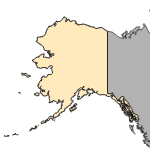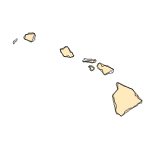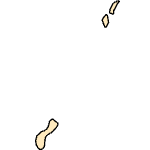Heteropsyllus nr. nunni
(a copepod)
Crustaceans-Copepods
Unknown |
|
Common name: a copepod
Identification: Heteropsyllus nr. nunni similar to H. nunni, but differs in overall body shape and the specific morphology of the 5th leg (Garza and Whitman 2004).
Heteropsyllus nunni can be distinguished from other Heteropsyllus spp. by the 1st endopod segment on leg 1, which is shorter than the whole exopod, and the relatively large rostrum (extended portion of the head). The caudal rami (two branches on the tail) exhibit short terminal setae and stout outer setae. There is an oval-shaped plate on the dorsal surface in the cephalothoracic region that may be where cyst formation takes place (Coull and Palmer 1980; Coull and Grant 1981; Lesko et al. 2003).
Size: ~510 µm long (Horvath et al. 2001)
Native Range: Unknown, given that H. nr. nunni may be a separate species from H. nunni. Heteropsyllus nunni is native to the Atlantic coast of North America, while most other Heteropsyllus spp. are native to coastal marine areas of northern Europe (Horvath et al. 2001).



|

Alaska |

Hawaii |

Puerto Rico &
Virgin Islands |

Guam Saipan |
Hydrologic Unit Codes (HUCs) Explained
Interactive maps: Point Distribution Maps
Nonindigenous Occurrences:
Table 1. States with nonindigenous occurrences, the earliest and latest observations in each state, and the tally and names of HUCs with observations†. Names and dates are hyperlinked to their relevant specimen records. The list of references for all nonindigenous occurrences of Heteropsyllus nr. nunni are found here.
Table last updated 1/14/2026
† Populations may not be currently present.
Ecology: Heteropsyllus nunni generally occurs at high densities in winter. Nauplii (newly hatched individuals) mature in spring, become adults by early summer, and encyst for 3–4 months during the summer. Females and males mate after encystment occurs and females produce eggs one week after mating (Williams-Howze 1996). Heteropsyllus nunni is the only known marine harpacticoid copepod that has a diapause stage within a cyst (Coull and Grant 1981; Williams-Howze and Coull 1992; Williams-Howze 1996; Williams and Biesiot 2004).
Heteropsyllus nr. nunni from Lake Michigan does not, however, appear to exhibit the winter univoltine (one generation per year) reproductive strategy of H. nunni. Adults in Lake Michigan occur at high densities in both July and December (Horvath et al. 2001). Heteropsyllus nr. nunni occurs from 1–15 m depth in Lake Michigan and densities are highest at 9 m. It is a nearshore benthic species found on sand substrate (Horvath et al. 2001). Similarly, H. nunni on the Atlantic coast of North America can occur in very shallow water sand flats (Williams-Howze and Coull 1992).
Means of Introduction: Probably introduced in ballast water, like most other copepod species introduced to the Great Lakes (Horvath et al. 2001).
Status: Established in Lake Michigan and northwestern Lake Huron. Its status in Lake St. Clair is uncertain at present.
Impact of Introduction:
A) Realized: Heteropsyllus nr. nunni dominates the harpacticoid community in shallow sites (up to 9 m) in Lake Michigan. This may either be due to successful competition with native species for similar resources or the ability to exploit unused resources (Horvath et al. 2001; Garza and Whitman 2004).
B) Potential: None documented.
References: (click for full references)
Coull, B.C., and J. Grant. 1981. Encystment discovered in a marine copepod
Heteropsyllus nunni. Science 212(4492): 342-344.
Coull, P.C., and M.A. Palmer. 1980. Heteropsyllus (Copepods, Harpacticoida): a revised key, including a new species from Chesapeake Bay. Transactions of the American Microscopical Society 99(3): 303-309.
Garza, E.L., and R.L. Whitman. 2004. The nearshore benthic invertebrate community of southern Lake Michigan and its response to beach nourishment. Journal of Great Lakes Research 30(1): 114-122.
GLMRIS. 2012. Appendix C: Inventory of Available Controls for Aquatic Nuisance Species of Concern, Chicago Area Waterway System. U.S. Army Corps of Engineers.
Horvath, T.G., R.L. Whitman, and L.L. Last. 2001. Establishment of two invasive crustaceans (Copepoda: Harpacticoida) in the nearshore sands of Lake Michigan. Canadian Journal of Fisheries and Aquatic Sciences 58: 1261-1264.
Lesko, L.T., P.L. Hudson, J.W. Reid, and M.A. Chriscinske. 2003. Harpacticoid copepods of the Laurentian Great Lakes. Great Lakes Science Center, Ann Arbor, Michigan. http://www.glsc.usgs.gov/greatlakescopepods/Key.asp?GROUP=Harpacticoid
Williams, J.L., and P.M. Biesiot. 2004. Lipids and fatty acids of the benthic marine harpacticoid copepod Heteropsyllus nunni Coull during diapause: a contrast to pelagic copepods. Marine Biology (Berlin) 144(2): 335-344.
Williams-Howze, J. 1996. The biology and morphology of the marine harpacticoid copepod Heteropsyllus nunni Coull, during encystment diapause. Hydrobiologia 320(1-3): 179-189.
Williams-Howze, J., and B.C. Coull. 1992. Are temperature and photoperiod necessary cues for encystment in the marine benthic harpacticoid copepod Heteropsyllus nunni Coull? Biological Bulletin (Woods Hole) 182: 109-116.
Author:
Kipp, R.M., J. Larson, T.H. Makled, and A. Fusaro
Revision Date: 9/12/2019
Citation Information:
Kipp, R.M., J. Larson, T.H. Makled, and A. Fusaro, 2026, Heteropsyllus nr. nunni Coull, 1975: U.S. Geological Survey, Nonindigenous Aquatic Species Database, Gainesville, FL, https://nas.er.usgs.gov/queries/FactSheet.aspx?SpeciesID=2659, Revision Date: 9/12/2019, Access Date: 1/15/2026
This information is preliminary or provisional and is subject to revision. It is being provided to meet the need for timely best science. The information has not received final approval by the U.S. Geological Survey (USGS) and is provided on the condition that neither the USGS nor the U.S. Government shall be held liable for any damages resulting from the authorized or unauthorized use of the information.